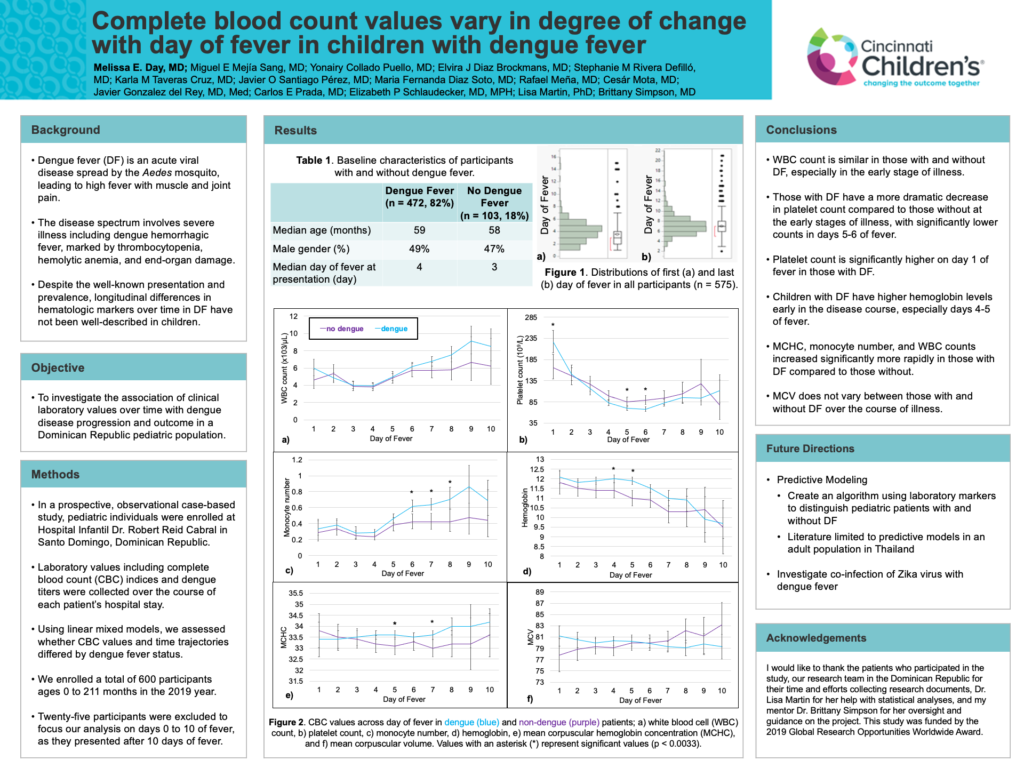Complete Blood Count Values Vary in Degree of Change with Day of Fever in Children with Dengue Fever
Melissa E. Day, MD; Javier Gonzalez del Rey, MD, MEd; Miguel E Mejía Sang, MD; Elvira J Diaz Brockmans, MD; Yonairy Collado Puello, MD; Stephanie M Rivera Defilló, MD; Karla M Taveras Cruz, MD; Javier O Santiago Pérez, MD; Ammar Husami, BS; Val Pilipenko, PhD; Rafael Meña, MD; Cesár Mota, MD; Carlos E Prada, MD; Lisa Martin, PhD; Brittany Simpson, MD

Certain CBC measures differ (both in absolute values and changes through disease course) between those with and without dengue fever, despite similar clinical presentation. These laboratory differences may facilitate a predictive algorithm to distinguish those with and without dengue fever in resource-limited settings
-Melissa Day, MD
Abstract
Background: Dengue fever (DF) is an acute viral disease spread by the Aedes mosquito, leading to symptoms of high fever with muscle and joint pain. The disease spectrum involves severe illness including dengue hemorrhagic fever, marked by thrombocytopenia and hemolytic anemia as well as end-organ damage. Despite the well-known presentation and prevalence, longitudinal differences in hematologic markers during the course of DF have not been well-described in children.
Objective: To investigate the association of clinical laboratory values over time with dengue disease progression and outcome in a Dominican Republic pediatric population.
Methods: In a prospective, observational case- based study, pediatric-aged participants were enrolled at Hospital Infantil Dr. Robert Reid Cabral in Santo Domingo, Dominican Republic. Laboratory values including complete blood count (CBC) indices were collected over the course of each patient’s hospital stay, as well as dengue titer results. Using linear mixed models, we assessed whether 13 CBC values and time trajectories differed by dengue status, including age and sex as covariates. To account for multiple testing, p≤0.0033 was considered significant.
Results: A total of 575 children ages 0 to 211 months met inclusion criteria; 51.8% (n=298) were male, and the median (IQR) age was 59 (14-93) months. Eighty-two percent (n=472) of participants had DF. Those with DF had a higher hematocrit (34.9 versus 33.4), hemoglobin (11.7 versus 11.1), mean corpuscular hemoglobin concentration (MCHC; 33.6 vs 33.2), monocyte percentage (0.09 vs 0.08), and monocyte number (0.45 vs 0.33) compared to those without DF (p≤0.0009 for all). Platelet count was lower in those with DF (85.6 vs 100.5; p<0.0001). Those with DF showed levels dropping more quickly across days of fever for hematocrit and hemoglobin (p≤ 0.002). Those with DF had levels increasing more quickly for MCHC, monocyte number, and WBC counts (p≤0.003). The direction of the change across time differed by DF status for MCV and RDW (p≤0.0003).
Conclusions: Certain CBC measures differ (both in absolute values and changes through disease course) between those with and without DF, despite similar clinical presentation. These laboratory differences may facilitate a predictive algorithm to distinguish those with and without DF in resource-limited settings.